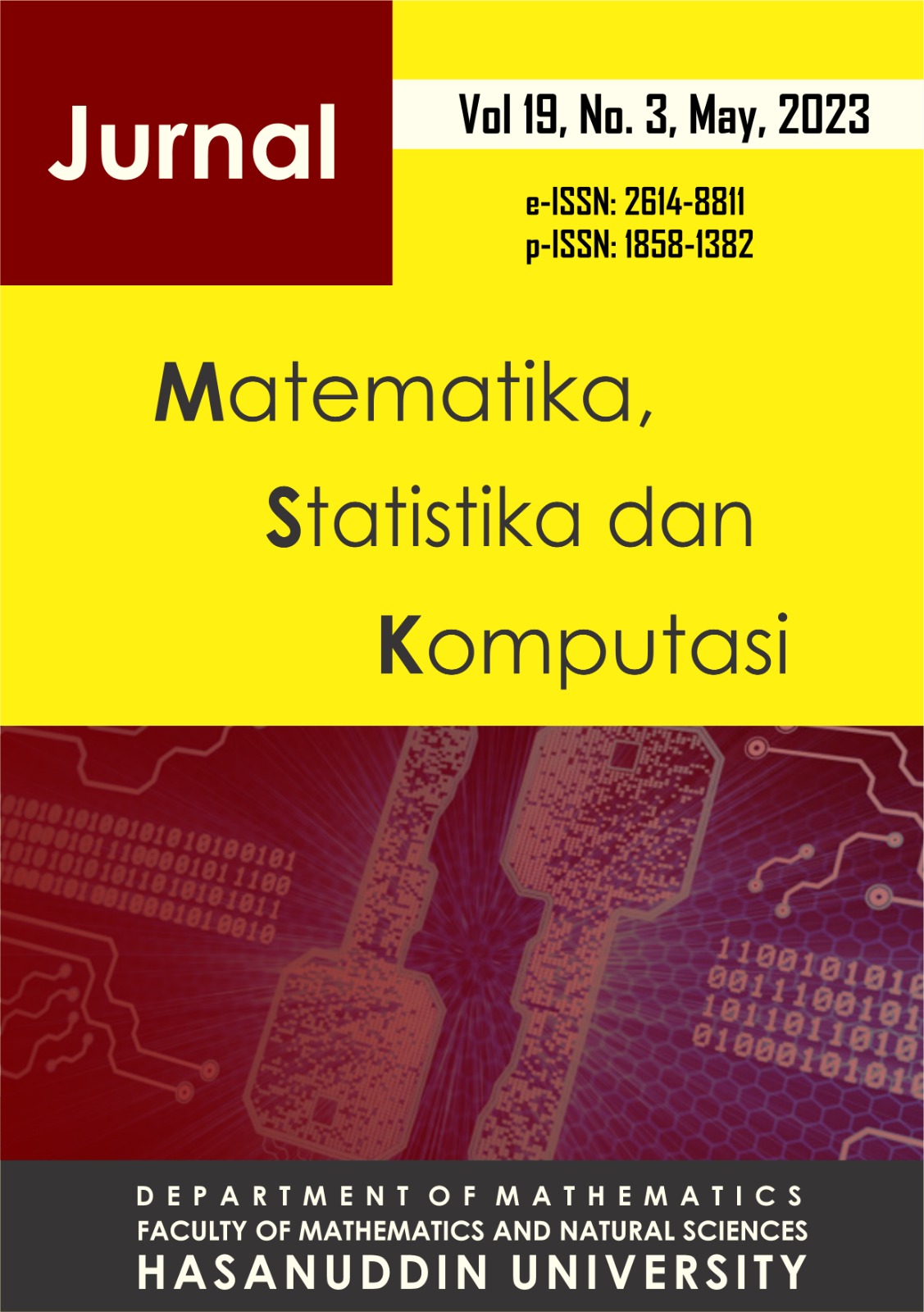Local Stability of Equilibrium Point of the Tuberculosis Transmission Model
DOI:
https://doi.org/10.20956/j.v19i3.25843Keywords:
Local Stability, TB Disease, Basic Reproduction NumberAbstract
A crucial part of illness prevention over the past few decades has been played by mathematical models. The dynamic system can be used to characterize the TB infection process. For the purpose of developing future prevention strategies, it is crucial to comprehend the effect of vaccination approach on the control of TB. We investigated the impact of vaccination strategies on TB disease transmission through a dynamic model. The model discussed involves logistical population growth. The purpose of this discussion is to analyze the local stability of the equilibrium point of the TB disease transmission model. Numerical simulations are provided to illustrate the theoretical results. The existence and local stability of the model equilibrium point depends on the basic reproduction number analytically. Based on secondary data, the basic reproduction number values are 0.98 and 4.12, respectively. Numerical simulations for these two values support the analysis results obtained. If the basic reproduction number is less than one, then the transmission of TB disease can be eradicated. However, if the basic reproduction number is more than one, the vaccination strategy is not sufficient to control TB transmission.Downloads
References
Aparicio, J. P., & Castillo-Chavez, C., 2009. Mathematical modelling of tuberculosis epidemics. Mathematical Biosciences and Engineering, 6(2). https://doi.org/10.3934/mbe.2009.6.209
Blower, S. M., Small, P. M., & Hopewell, P. C., 1996. Control strategies for tuberculosis epidemics: New models for old problems. Science, 273(5274). https://doi.org/10.1126/science.273.5274.497
Blower, Sally M., & Chou, T., 2004. Modeling the emergence of the “hot zones”: Tuberculosis and the amplification dynamics of drug resistance. Nature Medicine, 10(10). https://doi.org/10.1038/nm1102
Castillo-Chavez, C., & Feng, Z., 1998. Global stability of an age-structure model for TB and its applications to optimal vaccination strategies. Mathematical Biosciences, 151(2). https://doi.org/10.1016/S0025-5564(98)10016-0
Das, D. K., Khajanchi, S., & Kar, T. K., 2020. Transmission dynamics of tuberculosis with multiple re-infections. Chaos, Solitons and Fractals, 130. https://doi.org/10.1016/j.chaos.2019.109450
Henson, S. M., Brauer, F., & Castillo-Chavez, C., 2003. Mathematical Models in Population Biology and Epidemiology. The American Mathematical Monthly, 110(3). https://doi.org/10.2307/3647954
Khajanchi, S., Das, D. K., & Kar, T. K., 2018. Dynamics of tuberculosis transmission with exogenous reinfections and endogenous reactivation. Physica A: Statistical Mechanics and Its Applications, 497. https://doi.org/10.1016/j.physa.2018.01.014
Kim, S., de los Reyes, A. A., & Jung, E., 2018. Mathematical model and intervention strategies for mitigating tuberculosis in the Philippines. Journal of Theoretical Biology, 443, 100–112. https://doi.org/10.1016/j.jtbi.2018.01.026
Liu, L., Zhao, X. Q., & Zhou, Y., 2010. A tuberculosis model with seasonality. Bulletin of Mathematical Biology, 72(4). https://doi.org/10.1007/s11538-009-9477-8
Liu, S., Yang, X., Bi, Y., & Li, Y., 2019. Dynamic behavior and optimal scheduling for mixed vaccination strategy with temporary immunity. Discrete and Continuous Dynamical Systems - Series B, 24(4). https://doi.org/10.3934/dcdsb.2018216
Mengistu, A. K., & Witbooi, P. J., 2019. Modeling the Effects of Vaccination and Treatment on Tuberculosis Transmission Dynamics. Journal of Applied Mathematics, Volume 201, 1–9. https://doi.org/10.1155/2019/7463167
Mondal, P. K., & Kar, T. K., 2017. Optimal treatment control and bifurcation analysis of a tuberculosis model with effect of multiple re-infections. International Journal of Dynamics and Control, 5(2). https://doi.org/10.1007/s40435-015-0176-z
Nepomuceno, E. G., Takahashi, R. H. C., & Aguirre, L. A., 2018. Reducing vaccination level to eradicate a disease by means of a mixed control with isolation. Biomedical Signal Processing and Control, 40. https://doi.org/10.1016/j.bspc.2017.09.004
Nkamba, L. N., Manga, T. T., Agouanet, F., & Manyombe, M. L. M., 2019. Mathematical model to assess vaccination and effective contact rate impact in the spread of tuberculosis. Journal of Biological Dynamics, 13(1). https://doi.org/10.1080/17513758.2018.1563218
Perko, L., 2001. Differential Equations and Dynamical Systems, Third Edition. Springer-Verlag, New York.
Pinto, E. R., Nepomuceno, E. G., & Campanharo, A. S. L. O., 2019. Influence of Contact Network Topology on the Spread of Tuberculosis. Communications in Computer and Information Science, 1068 CCIS. https://doi.org/10.1007/978-3-030-36636-0_6
Sharomi, O., Podder, C. N., Gumel, A. B., & Song, B., 2008. Mathematical analysis of the transmission dynamics of HIV/TB coinfection in the presence of treatment. Mathematical Biosciences and Engineering, 5(1). https://doi.org/10.3934/mbe.2008.5.145
Song, B., Castillo-Chavez, C., & Aparicio, J. P., 2002. Tuberculosis models with fast and slow dynamics: The role of close and casual contacts. Mathematical Biosciences, 180(1–2). https://doi.org/10.1016/S0025-5564(02)00112-8
Verhulst, 2006. Ordinary Differential Equations with Applications. In Ordinary Differential Equations with Applications. https://doi.org/10.1007/0-387-35794-7
Waaler, H., Geser, A., & Andersen, S., 1962. The use of mathematical models in the study of the epidemiology of tuberculosis. American Journal of Public Health and the Nation’s Health, 52(6), 1002–1013. https://doi.org/10.2105/AJPH.52.6.1002
Yang, Y., Tang, S., Ren, X., Zhao, H., & Guo, C., 2016. Global stability and optimal control for a tuberculosis model with vaccination and treatment. Discrete and Continuous Dynamical Systems - Series B, 21(3). https://doi.org/10.3934/dcdsb.2016.21.1009
Zhou, Y., Khan, K., Feng, Z., & Wu, J., 2008. Projection of tuberculosis incidence with increasing immigration trends. Journal of Theoretical Biology, 254(2). https://doi.org/10.1016/j.jtbi.2008.05.026
Downloads
Published
How to Cite
Issue
Section
License
Copyright (c) 2023 Author and publisher

This work is licensed under a Creative Commons Attribution 4.0 International License.

This work is licensed under a Creative Commons Attribution 4.0 International License.
Jurnal Matematika, Statistika dan Komputasi is an Open Access journal, all articles are distributed under the terms of the Creative Commons Attribution License, allowing third parties to copy and redistribute the material in any medium or format, transform, and build upon the material, provided the original work is properly cited and states its license. This license allows authors and readers to use all articles, data sets, graphics and appendices in data mining applications, search engines, web sites, blogs and other platforms by providing appropriate reference.








